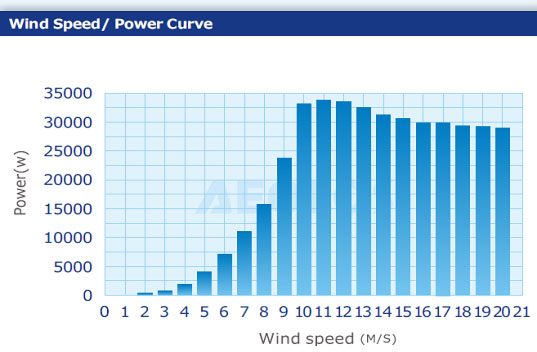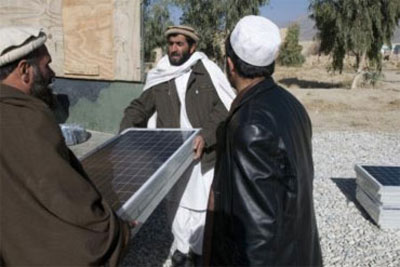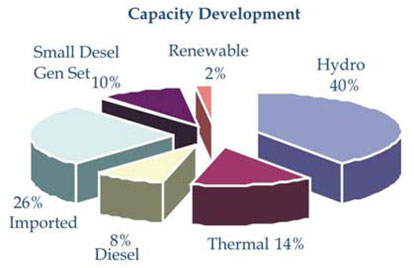Winds of Change: Renewable Power in Afghanistan
The North Atlantic Treaty Organization’s (NATO) International Security Assistance Force (ISAF) has been aggressively building infrastructure in Afghanistan to facilitate the country’s stabilization. The majority of U.S. Army Corps of Engineers (USACE) construction projects are new facilities for the Afghan National Police and the Afghan National Army. Nearly all these facilities require on-site power generation, which comes from diesel generators.
The reason for this is simply that Afghanistan has little electrical power infrastructure in many parts of the country. Typically, only the major towns or cities have any form of electrical grid, and often the power that does exist is not reliable or in limited supply. In Herat City in western Afghanistan, for example, power lines from Iran and Turkmenistan supply the city with electricity, but there isn’t enough for everyone, especially for a rapidly expanding population.
Camp Zafar, the Afghan National Army base about 20 km (12.5 miles) south of Herat City with approximately 4,000 soldiers, uses an average of 8,600 liters (2,270 gallons) of diesel fuel per day. The power plant consists of (six) one-megawatt diesel generators. Outside the power plant sits a fuel farm with several large diesel tanks filled regularly with fuel purchased from Iran and Turkmenistan. This example is repeated in various facilities of different sizes all across the country, with literally hundreds of fuel tankers driving into Herat everyday from across the borders. The demand for diesel fuel has skyrocketed during the last several years, and although it solves the power demand currently, it is an ever-increasing burden to sustain. Most people agree that diesel-powered generation is not a viable or sustainable long-term solution. The fuel cost is not stable; the fuel supply is not guaranteed; and the nation’s security is at stake because it is subject to foreign fuel control.
The Afghanistan National Development Strategy (ANDS) has identified alternative energy as a high value power source to develop. Traditional power sources are hydropower and coal, with potential gas reserves as well. But, renewable energy from solar and wind also are excellent alternatives in Afghanistan. Herat is known for a wind so predictable that it has been named the “120-day wind.” Western Afghanistan also experiences good wind velocity throughout the rest of the year. With these conditions, Afghanistan and its partners should investigate wind power as a viable alternative.
To make this program a success, it is essential to find Afghan partners capable of taking ownership of any initial development and then continuing the program’s work. Engineering professors from Herat University have shown significant interest and have gained the Dean’s support. In addition, one of the engineering professors has specialized training in wind turbine power systems. Other partners in western Afghanistan also are interested in pursuing wind power to support projects benefiting the Afghan population.
The U.S. Agency for International Development (USAID) has done groundbreaking work on developing clean, renewable energy in Afghanistan. One such project – the Afghan Clean Energy Project (ACEP) – is promoting increased use of renewable energy and establishing a local renewable energy equipment and service industry. USAID has teamed up with the National Renewable Energy Laboratory (NREL) to develop a wind map identifying approximately 158,000 megawatts of untapped potential wind energy predominantly located in western Afghanistan. Tapping into this power by installing wind turbine farms could solve not only the energy needs of the army and police but also move to electrify much of western Afghanistan. This, in turn, would increase the country’s security, better its financial position, create jobs and move it toward economic and environmental soundness.
According to the Afghanistan Ministry of Energy and Water, “The overall goal is to provide sustainable power supply, at affordable prices, and in an environmentally sound manner.” Wind power can help meet this objective. The Afghan utility provider, Da Afghanistan Breshna Sherkat (DABS), operates and manages the electric power generation, import, transmission and distribution. Wind power generation may help DABS with providing power in western Afghanistan.
In the United States, the cost of wind power is measured ultimately against the price per kilowatt hour of electricity. In a basic sense, it is the payback period of the installed cost of a wind turbine given the market rate of electricity. With an electric utility grid already in place, the rates are relatively low and the payback period therefore long without government subsidies.
In Afghanistan, the economics are different. Since power production and distribution systems are still in the development stage, the effective cost of a wind turbine system would be reduced when assessed against the comparative cost of a conventional power plant. According to the Afghanistan
Energy Sector Strategy, diesel generation costs almost 30 U.S. cents per kilowatt hour in 2008, and it is even higher today with increased diesel costs. A preliminary estimate of installed costs of large commercial wind turbines is in the range of $1,750 to $2,250 per kilowatt. A reasonable estimate of 30 percent efficiency can be used for initial calculations, which in basic terms means 30 percent of the time the wind is blowing at design speeds (10 meters/second or 22 miles per hour) or better. Given this estimate, the payback period would be seven to nine years using 10 U.S. cents per kilowatt hour. One strategic goal could be to replace the most expensive diesel generated power, which represents 26 percent of the 2007 power capacity according to ANDS.
Before putting up a large commercial wind turbine, however, research needs to be done to assess wind quantity and quality. The NREL report shows where in general the best wind areas are. But, specific wind data is needed to get the proper turbine designed for the site. Wind data can be determined from anemometers or from small wind turbines. A small wind turbine has the added benefit of also providing electricity. Given that, the primary goal for the first phase of this proposed wind program is to gather wind data from small wind turbines that can be used to size commercial wind turbines in the future. The Afghan Energy Information Center will be able to collect this data through Herat University or other owners or operators of wind turbines and have it available to DABS or other companies that can work toward meeting the goals of ANDS.
These sites are anticipated to be located at various schools and industrial or commercial sites. They will each provide annual wind data through a monitoring program for the local area. They will also provide electricity for each school or other facility where they are located for an estimated period of 30 years. Additionally, they will provide an education program for the engineering students and inspire private investors or the government to begin putting in large commercial systems. Some sites have already been selected, and more sites are being analyzed for these possible locations. Aeolos Wind Energy is one company that has been willing to do business in Afghanistan and provide assistance with developing the specifications for the small wind turbines. The typical proposed size of these turbines is 30 kilowatt, which has the potential to produce 30 kilowatts of power in winds at or above 10 meters per second (m/s) or 22 miles per hour.

Fig. 2 – 30 Kw power generation – © Aeolos wind Energy, Ltd
Including key Afghan leaders and institutions can ensure program success by their enduring presence, their vested interest for study and their ability to oversee and ensure maintenance and to provide data to interested parties. The prospects for this wind power program appear to have a critical role in national security with significant potential for Afghanistan’s future .






























